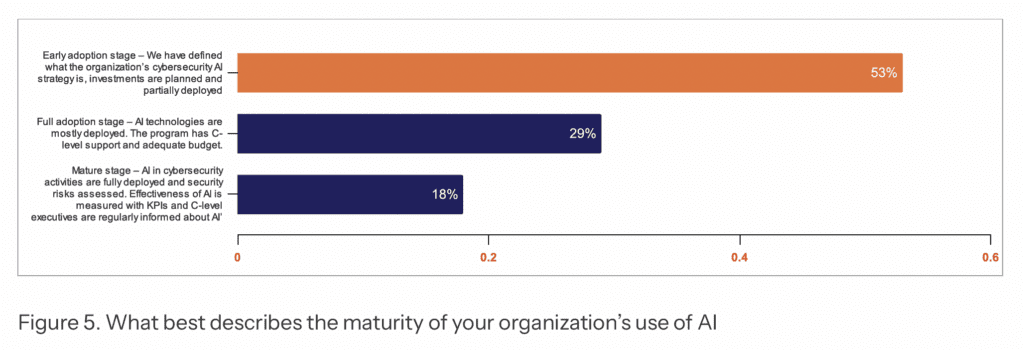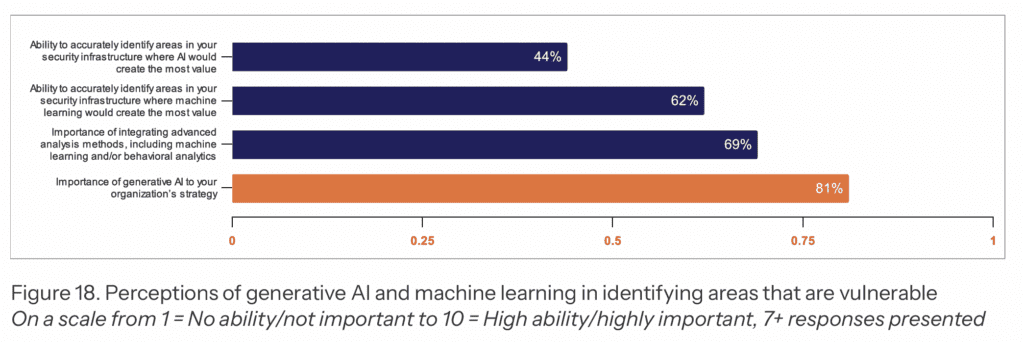 Joe Ariganello VP of Product Marketing
Joe Ariganello VP of Product Marketing
Joe is the VP of Product Marketing at MixMode. He has led product marketing for multiple cybersecurity companies, with stops at Anomali, FireEye, Neustar and Nextel, as well as various start-ups. Originally from NY, Joe resides outside Washington DC and has a BA from Iona University.
The cybersecurity landscape is a constant arms race. As attackers refine their tactics, organizations must continuously adapt and improve their defenses. Artificial intelligence (AI) has emerged as a powerful tool in this fight, promising to automate tasks, improve threat detection, and enhance overall security posture.
MixMode’s inaugural State of Cybersecurity Report 2024 indicates that many organizations are still in the early stages of AI adoption for cybersecurity, highlighting the need for a measured and risk-aware approach.
The Gradual Embrace of AI: Early Stages and Measured Steps

The report revealed a cautious optimism surrounding AI in cybersecurity. While a significant portion (53%) of respondents acknowledge their organization’s early-stage adoption of AI, only 18% report full deployment into integrated security programs. This cautious approach reflects the need for careful planning and implementation to ensure AI enhances, rather than hinders, security posture.
Several factors may contribute to this measured adoption:
- Complexity of AI Integration: Implementing AI effectively requires expertise in cybersecurity, data science, and machine learning. Organizations without these resources may face challenges during integration.
- Data Security Concerns: AI algorithms rely on vast amounts of data to learn and function effectively. Ensuring the security and privacy of this data is paramount.
- Uncertainty around ROI: While the potential benefits of AI are promising, quantifying the return on investment (ROI) can be challenging. Organizations may hesitate to commit significant resources without a clear understanding of the financial payback.
Risk Assessment: A Critical Step in the AI Journey
The report emphasizes the importance of security risk assessment throughout the AI adoption process. Integrating AI introduces new elements into the security landscape, and potential vulnerabilities must be identified and mitigated.
Here are some key considerations to assess when implementing AI:
- Data Biases: AI algorithms can inherit biases from the data on which they are trained. These biases can lead to inaccurate threat detection or an abundance of false positives.
- Explainability of AI Decisions: Understanding how AI systems reach conclusions is crucial for security teams to trust their recommendations and ensure they align with security policies.
- Potential for Misuse: Like any powerful tool, AI can be misused by malicious actors. Organizations must have safeguards to prevent attackers from exploiting vulnerabilities in AI systems.
By conducting thorough risk assessments at each stage of AI adoption, organizations can minimize potential security risks and ensure AI contributes to a more robust security posture.
The Promise of Advanced AI Methods: Looking Beyond Basic Applications

Despite the cautious approach, MixMode’s research reveals a strong appetite for advanced AI methods in cybersecurity. Most respondents believe integrating advanced analysis methods (69%) and generative AI (81%) is very important.
- Advanced Analysis Methods: These methods, like self-supervised learning or deep learning, can go beyond simple anomaly detection and identify complex patterns indicative of sophisticated cyberattacks.
- Generative AI: This type of AI can create realistic simulations of cyberattacks, allowing security teams to test their defenses and identify potential weaknesses before an attack occurs.
The integration of these advanced methods holds significant promise for the future of cybersecurity, potentially leading to:
- Improved Threat Detection: AI can analyze vast amounts of data in real-time, identifying subtle anomalies that might evade traditional detection methods.
- Predictive Security: AI can analyze past attack data and predict future attack vectors, allowing organizations to strengthen their defenses proactively.
- Automated Incident Response: AI can automate tasks associated with incident response, freeing up security analysts to focus on complex decision-making and investigation.
Overcoming Adoption Hurdles in a Wary Industry
The State of AI in Cybersecurity report also revealed organizations’ complex hurdles when integrating AI into their cybersecurity infrastructure. Top challenges included:
- Security Architecture Streamlining (64%): Existing security systems may be a labyrinth of tools and processes. Integrating AI smoothly requires simplifying this architecture to ensure compatibility and efficient data flow.
- Legacy System Integration (65%): Many organizations rely on older systems that are not designed to work with AI. Integrating these systems with new AI-powered tools can be a monumental task.
- In-House Expertise Gap (65%): Implementing and maintaining AI security solutions requires specialized skills. Organizations may need to upskill existing staff or hire new talent with expertise in AI and cybersecurity.
- External Expertise Needed (54%): The gap in internal expertise often necessitates relying on external consultants to maximize the value of AI security solutions. This can add to the overall cost and complexity of adoption.
The Ghost of False Promises Past
These technical challenges are compounded by a lingering skepticism within the cybersecurity industry. Past encounters with AI solutions that overpromised and underdelivered have left some security professionals wary.
Vendors may have touted AI as a magic bullet, neglecting the need for human expertise and robust data sets to train and maintain these systems effectively. These inflated claims led to unrealistic expectations and, ultimately, disillusionment.
A New Era of AI-Powered Security
Despite these challenges, the potential of AI in cybersecurity is undeniable. The key lies in a measured and realistic approach. Organizations must:
- Focus on specific use cases: Instead of implementing AI broadly, identify areas where AI can provide the most significant benefit, like assisting cybersecurity professionals with threat detection or anomaly analysis.
- Invest in the fundamentals: Ensure a strong foundation of cybersecurity hygiene before integrating AI. This includes robust password policies, regular security awareness training, and up-to-date security software.
- Embrace a human-AI partnership: AI is a powerful tool but not a replacement for human intelligence and security analysts. The best approach leverages the strengths of both – AI’s tireless processing power and human expertise in critical decision-making.
By acknowledging the challenges and adopting a strategic approach, organizations can harness AI’s true power to build a more secure digital future. AI is not a silver bullet, but it can be a valuable weapon in the fight against cybercrime, helping to secure our increasingly interconnected world.
MixMode: Lowering the Barrier to Entry for AI-powered Threat Detection
MixMode can help bridge the gap for organizations to embrace AI and implement a powerful threat detection solution to help defend against cyber threats:
Reduced Complexity:
- Easy Integration: MixMode boasts a quick and easy setup process. This minimizes disruption and allows security teams to leverage AI rapidly.
Focus on Security Expertise:
- Improved Efficiency: MixMode automates the threat detection process and allows security teams to do more with less. This is crucial in today’s ever-growing threat landscape.
Third-Wave AI for Advanced Threat Detection:
- Self-Supervised Learning: MixMode’s AI utilizes self-supervised learning to understand an organization’s network autonomously. This eliminates the need for pre-defined rules and allows continuous adaptation to evolving threats.
A Measured Embrace of AI for a Secure Future

The State of Cybersecurity Report 2024 paints a picture of a cybersecurity landscape cautiously embracing AI. While the technology holds immense promise, organizations are understandably taking a measured approach, prioritizing security risk assessment throughout the adoption process.
MixMode empowers organizations to confidently embrace the future of cybersecurity by simplifying AI adoption and offering novel threat detection capabilities. Download the report to learn more about the State of Cybersecurity Report, or contact us today to learn how MixMode can implement an advanced AI solution to build a more resilient infrastructure.
Other MixMode Articles You Might Like
MixMode Garners Spot in 2024 CRN® Partner Program Guide
The AI Advantage: Mitigating the Security Alert Deluge in a Talent-Scarce Landscape
MixMode Included on Forbes’ America’s Best Startup Employers 2024 List
The Evolving Threat Landscape: Why AI is Essential for Cybersecurity Success
*** This is a Security Bloggers Network syndicated blog from MixMode authored by Joe Ariganello. Read the original post at: https://mixmode.ai/blog/navigating-the-maze-a-measured-approach-to-ai-adoption-in-cybersecurity/
